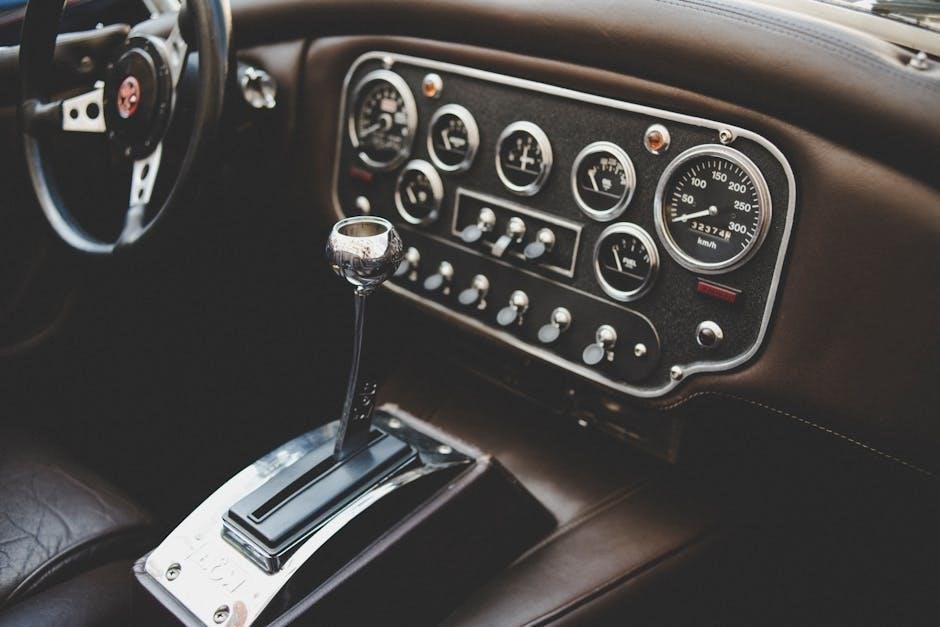
6 speed manual vs 5 speed manual
Manual transmissions offer precise control over gear selection, enhancing driving engagement and performance. The debate between 5-speed and 6-speed manuals focuses on gear ratios, efficiency, and driving dynamics, impacting both fuel economy and acceleration. Understanding these differences helps drivers choose the ideal setup for their needs;
Overview of 5-Speed and 6-Speed Manual Transmissions
A 5-speed manual transmission offers five forward gears, ideal for entry-level or older vehicles, providing simplicity and ease of use. It typically features closer gear ratios, keeping the engine in its power band for better low-end performance; In contrast, a 6-speed manual transmission adds an extra gear, enhancing versatility and efficiency. This setup is common in sports and high-performance cars, allowing for smoother acceleration and improved fuel economy at higher speeds. The additional gear in the 6-speed enables drivers to maintain optimal engine RPMs, reducing wear and tear while delivering a more engaging driving experience. Both transmissions cater to different driving preferences, with the 5-speed offering simplicity and the 6-speed providing advanced control.

Understanding the Basics
A 5-speed manual transmission offers five forward gears, ideal for entry-level vehicles, while a 6-speed adds an extra gear for enhanced control and efficiency at higher speeds.
What is a 5-Speed Manual Transmission?
A 5-speed manual transmission is a type of gearbox offering five forward gears and one reverse gear. It is commonly found in older or entry-level vehicles due to its simplicity and lower production costs. This setup provides a straightforward driving experience, with gear ratios optimized for everyday use. The 5-speed manual is known for its ease of use, especially in city driving, where frequent shifting is required. It typically features closer ratios between the first, second, and third gears, keeping the engine in its power band for better low-speed acceleration. However, it may lack the overdrive capabilities of a 6-speed, making it less efficient at high speeds.
What is a 6-Speed Manual Transmission?
A 6-speed manual transmission is a gearbox featuring six forward gears and one reverse gear, designed for enhanced performance and efficiency. It provides a broader range of gear ratios compared to a 5-speed, allowing for smoother acceleration and better fuel economy, especially at higher speeds. The additional gear enables drivers to maintain optimal engine RPMs during highway driving, reducing fuel consumption and engine strain. This setup is often favored in sports and high-performance vehicles, where precise control and versatility are crucial. The 6-speed manual also offers closer gear ratios, ensuring seamless transitions between gears and a more engaging driving experience. Its design caters to drivers seeking both power and efficiency, making it a popular choice for modern vehicles.

Key Differences
The primary distinction lies in the number of gear ratios, with the 6-speed offering an extra gear for improved acceleration and fuel efficiency, while the 5-speed remains simpler and more straightforward.
Number of Gears and Gear Ratios
The 6-speed manual transmission includes an additional forward gear compared to the 5-speed, providing more flexibility in gear selection. This extra gear allows for closer ratios between gears, enabling smoother acceleration and better optimization of engine power across various driving conditions. In contrast, the 5-speed manual offers a simpler setup with wider gear ratios, which can be sufficient for everyday driving but may lack the precision of its 6-speed counterpart. The 6-speed gearbox often features overdrive gears, reducing engine RPM at higher speeds for improved fuel efficiency and reduced noise. Conversely, the 5-speed may have a more straightforward design, making it lighter and less complex. The choice between the two ultimately depends on the driver’s needs for performance, efficiency, and simplicity.
Performance and Acceleration
The 6-speed manual transmission excels in performance and acceleration due to its additional gear, allowing for closer ratios and smoother power delivery. This enables drivers to maintain optimal engine RPMs during acceleration, particularly in high-performance scenarios. The 6-speed gearbox provides better control over power delivery, making it ideal for sporty driving. In contrast, the 5-speed manual has wider gear ratios, which can result in slightly less refined acceleration. However, the 5-speed is often lighter and simpler, making it a viable option for everyday driving where maximum performance is not a priority. The 6-speed offers enhanced responsiveness, while the 5-speed delivers a more straightforward driving experience, catering to different driver preferences and needs.

Advantages of Each
A 5-speed manual offers simplicity, lighter weight, and lower costs, making it ideal for everyday driving. A 6-speed manual provides better fuel efficiency and smoother acceleration, enhancing performance.
Benefits of a 5-Speed Manual Transmission
A 5-speed manual transmission is renowned for its simplicity and reliability, making it a cost-effective option for drivers. It typically features shorter gear ratios, which provide quicker acceleration in lower gears, ideal for city driving or when navigating steep inclines. The lightweight design of a 5-speed manual contributes to better fuel economy and lower maintenance costs compared to more complex transmissions. Additionally, the straightforward mechanism makes it easier to learn and master for new drivers, offering a more direct connection to the vehicle. This simplicity also reduces the risk of mechanical failures, ensuring a durable and hassle-free driving experience over time.
Benefits of a 6-Speed Manual Transmission
A 6-speed manual transmission offers enhanced performance and efficiency compared to its 5-speed counterpart. The additional gear provides a broader range of ratios, allowing for smoother acceleration and better fuel economy, especially at higher speeds. This makes it ideal for highway driving, where the engine can operate at lower RPMs, reducing wear and improving comfort. The 6-speed also delivers more precise control over power delivery, enabling drivers to optimize performance in various driving conditions. Its advanced gear ratios and improved synchronization contribute to a more responsive and engaging driving experience, making it a preferred choice for sports and high-performance vehicles. This versatility ensures a balance between efficiency and exhilaration, catering to both everyday drivers and enthusiasts alike.

Fuel Efficiency
Manual transmissions with more gears, like 6-speeds, often improve fuel economy by reducing engine RPM at higher speeds, while 5-speeds may require more engine effort, impacting efficiency.
How 5-Speed Manuals Impact Fuel Economy
A 5-speed manual transmission can influence fuel economy, particularly at higher speeds. With fewer gears, the engine may operate at higher RPMs during highway driving, potentially reducing efficiency. While city driving might not show a significant difference, the lack of an overdrive gear in some 5-speeds can lead to increased fuel consumption on long trips. However, the simplicity of a 5-speed can sometimes offset this, as it tends to be lighter and less complex than a 6-speed. Overall, fuel economy with a 5-speed manual is adequate but may not match the optimization offered by a 6-speed in certain conditions.
How 6-Speed Manuals Improve Fuel Efficiency
A 6-speed manual transmission enhances fuel efficiency primarily through optimized gear ratios and an additional overdrive gear. This setup allows the engine to operate at lower RPMs during highway driving, reducing fuel consumption. The extra gear provides a broader range of speeds, enabling the engine to stay within its efficient power band longer. Smoother transitions between gears also contribute to better mileage, especially in mixed driving conditions. While city driving may not see a dramatic improvement, the overall versatility of a 6-speed manual makes it more efficient than its 5-speed counterpart, particularly for drivers who frequently travel at higher speeds or carry heavy loads.

Driving Experience
A 6-speed manual offers enhanced control and versatility with an extra gear, providing smoother transitions and better adaptability to varying driving conditions, while a 5-speed remains straightforward and simple.
Smoothness and Gear Transitions in 5-Speed
A 5-speed manual transmission offers smooth and direct gear transitions, particularly in city driving and lower-speed conditions. The closer ratios between gears ensure consistent power delivery, making it easier to maintain momentum. However, the simplicity of the 5-speed design means it may lack the refined shifting experience of a 6-speed, especially at higher speeds. Drivers often appreciate the straightforward nature of the 5-speed, as it provides a more tactile connection to the vehicle. While it may not offer the same level of precision as its 6-speed counterpart, the 5-speed remains a reliable choice for everyday driving, delivering a balance of simplicity and performance.
Enhanced Control and Versatility in 6-Speed
A 6-speed manual transmission provides enhanced control and versatility, offering drivers more precise gear transitions and a broader range of driving scenarios. The additional gear allows for better optimization of engine power, especially at higher speeds, ensuring smoother acceleration and improved fuel efficiency. With closer gear ratios, the 6-speed transmission enables quicker shifts, which is particularly beneficial for performance-oriented driving. This setup is ideal for both city commutes and highway cruising, as it adapts seamlessly to varying conditions. The enhanced control and versatility make the 6-speed manual a preferred choice for drivers seeking a more dynamic and engaging driving experience, whether on winding roads or open highways.

Maintenance and Repair
Manual transmissions require regular maintenance to ensure optimal performance. Both 5-speed and 6-speed manuals need clutch replacements and fluid changes, but 6-speed systems may involve more complex repairs due to additional components, potentially increasing costs and maintenance frequency compared to simpler 5-speed setups.
Maintenance Needs for 5-Speed Manuals
Maintenance for 5-speed manual transmissions is relatively straightforward due to their simpler design. Regular tasks include clutch replacement, fluid changes, and inspection of gear linkages and seals. With fewer components than 6-speed systems, repairs are often less complex and costly. Drivers should also monitor the condition of the shift cables and mounting bushings to ensure smooth operation. While the 5-speed manual requires attention to these areas, its overall reliability and ease of repair make it a practical choice for those seeking lower maintenance demands compared to more advanced transmissions.
Maintenance Considerations for 6-Speed Manuals
Maintenance for 6-speed manual transmissions is slightly more involved due to the additional gear and complex components. Regular fluid changes and inspections of gear teeth, synchronizers, and bearings are essential. The extra gear adds complexity, potentially leading to higher repair costs if issues arise. Drivers should monitor shift quality and address any unusual noises promptly. Proper lubrication is critical to ensure smooth operation and longevity. While the 6-speed manual is durable, its intricate design may require more frequent maintenance checks compared to simpler 5-speed systems; Staying on top of these needs helps preserve performance and reliability over time.

Performance Dynamics
6-speed manuals deliver enhanced acceleration and smoother power delivery due to optimized gear ratios, while 5-speeds provide closer gear spacing for better low-end torque and responsiveness in specific driving scenarios.
Acceleration and Power Delivery in 5-Speed
A 5-speed manual transmission is known for its direct acceleration and responsiveness, particularly in lower gears. The closer ratio between gears ensures the engine stays within its power band, delivering immediate throttle response. This makes city driving and uphill climbs more manageable, as drivers can maintain momentum without frequent shifting. However, at higher speeds, the lack of an overdrive gear means higher engine RPMs compared to a 6-speed, potentially reducing efficiency. Despite this, the simplicity of a 5-speed often results in a more engaging and straightforward driving experience, appealing to those who prioritize quick acceleration and a direct connection to the vehicle’s power delivery.
Optimized Gear Ratios in 6-Speed
A 6-speed manual transmission excels with its optimized gear ratios, offering precise control over power delivery and acceleration. The additional gear allows for smoother transitions, especially in high-performance scenarios, ensuring the engine operates within its optimal power band. This results in quicker acceleration and better responsiveness compared to a 5-speed. The closer gear ratios enable drivers to maintain control during spirited driving, while the overdrive gear in sixth reduces engine RPMs at higher speeds, enhancing fuel efficiency. Overall, the 6-speed design provides a more refined and versatile driving experience, making it ideal for both everyday commuting and enthusiast-level performance.

Vehicle Applications
5-speed manuals are often found in entry-level and older vehicles, while 6-speed manuals are commonly used in sports and high-performance cars, offering enhanced fuel efficiency and smoother gear transitions.
5-Speed Manuals in Entry-Level and Older Vehicles
5-speed manual transmissions are commonly found in entry-level and older vehicles due to their simplicity and cost-effectiveness. These transmissions are lightweight and straightforward in design, making them ideal for smaller engines and basic driving needs. They provide a good balance of performance and fuel efficiency for city driving and moderate highway use. The compact design and lower production costs of 5-speed manuals make them a practical choice for budget-friendly vehicles. Additionally, their mechanical simplicity results in easier maintenance and repair compared to more complex transmissions. While they may lack the refined smoothness of modern 6-speed manuals, 5-speeds remain a reliable and accessible option for many drivers.
6-Speed Manuals in Sports and High-Performance Cars
6-speed manual transmissions are widely used in sports and high-performance vehicles due to their ability to deliver exceptional acceleration and precise control. The additional gear in a 6-speed setup allows for optimized gear ratios, enabling drivers to maintain optimal engine power across a broader range of speeds. This is particularly beneficial in high-performance driving scenarios, where quick shifts and seamless power delivery are crucial. The closer ratios in a 6-speed manual also enhance responsiveness, making it a preferred choice for enthusiasts seeking an engaging driving experience. Furthermore, the taller overdrive gears in these transmissions reduce engine RPM at high speeds, improving fuel efficiency and reducing noise during highway driving.

Driver Preferences
Driver preferences often hinge on lifestyle and driving habits. Casual drivers may favor the simplicity of a 5-speed, while enthusiasts prefer the precision and control of a 6-speed.
Why Choose a 5-Speed Manual?
A 5-speed manual transmission is ideal for drivers seeking simplicity and ease of use. It offers fewer gears, making it lighter and more straightforward to maintain. With closer ratios in lower gears, it provides better acceleration in city driving and is often preferred by those who value a direct, uncomplicated driving experience. Additionally, 5-speed manuals are typically found in older or entry-level vehicles, appealing to budget-conscious drivers. Its reliability and lower cost of ownership make it a practical choice for everyday commuting. For those who prioritize ease and simplicity without the need for advanced performance, a 5-speed manual remains a reliable and satisfying option.
Why Choose a 6-Speed Manual?
A 6-speed manual transmission is favored by drivers who desire enhanced performance and versatility. The additional gear offers smoother acceleration and better fuel efficiency, especially at higher speeds. It provides a broader range of gear ratios, allowing for optimal power delivery in various driving conditions. This makes it ideal for sports cars and high-performance vehicles, where precise control and quick shifts are crucial. The taller overdrive gears reduce engine RPMs at highway speeds, improving comfort and fuel economy. For enthusiasts seeking a more engaging and dynamic driving experience, the 6-speed manual is the preferred choice, offering superior flexibility and responsiveness compared to its 5-speed counterpart.
The choice between a 5-speed and 6-speed manual transmission depends on driving habits and preferences. The 6-speed offers enhanced performance and efficiency, while the 5-speed provides simplicity and cost-effectiveness. Both transmissions deliver unique advantages, making them suitable for different driving scenarios and vehicle types.